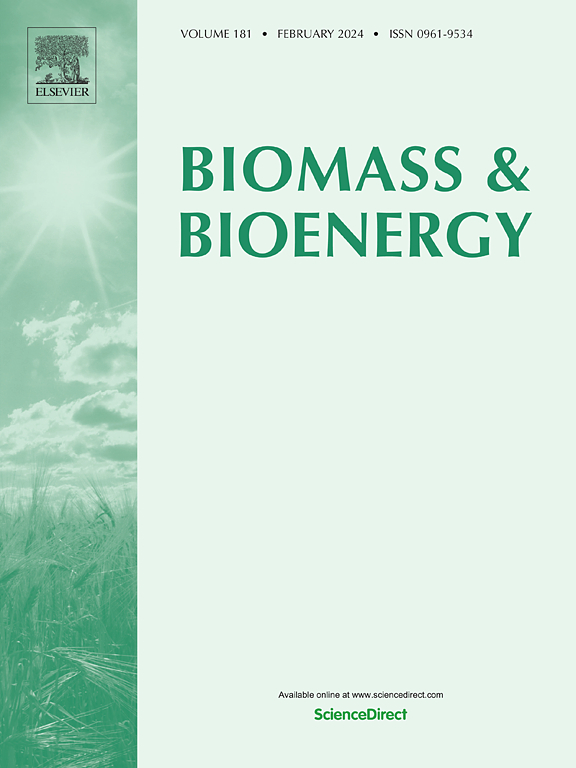臭氧预处理辅助催化加氢解聚木质素
IF 5.8
2区 生物学
Q1 AGRICULTURAL ENGINEERING
引用次数: 0
摘要
作为最重要的生物质资源之一,木质素因其丰富的芳香结构而被视为生产高价值化学品的理想原料。然而,木质素结构复杂、分子量大,即使在苛刻的加工条件下,也无法将其有效解聚成单体。在这项工作中,采用臭氧处理工艺对有机溶胶木质素进行预处理,然后进行催化加氢,以促进木质素的解聚。在不同酸碱环境下进行臭氧预处理后,木质素被初步解聚,臭氧产物可分为不溶性和水溶性两种,表明木质素的结构发生了一定程度的改变。此外,臭氧处理产物的截留分子量发生了明显变化,出乎意料的是,在 pH = 6、8 和 9 时得到的一些截留分子量不仅没有降低,反而随着可能的再缩合而升高。随后,在 pH = 10 时得到的臭氧产物因其最低的截留分子量(5574 g/mol)而被用作后续氢化工艺的原料。由于 Ni-Nb 复合材料具有良好的加氢脱氧活性,因此被用作氢化催化剂。在 280 °C 和 4.0 MPa 下氢化后,未经处理的有机溶胶木质素的单体产率为 19.5 wt%。相比之下,水溶性部分的单体产率更高(83.3 wt%),而不溶性部分的单体产率较低(12.5 wt%),这是因为 C-C 键的数量较多。这项研究证实,臭氧预处理增加了 C-C 键的相对含量,这可能会在一定程度上抑制水解聚合,但总的解聚率仍有所提高。本文章由计算机程序翻译,如有差异,请以英文原文为准。

Ozonation pretreatment-assisted catalytic hydrogenation for efficient depolymerization of lignin
As one of the most important biomass resources, lignin is regarded as an ideal feedstock to produce high-value chemicals because of the abundance of its aromatic structures. However, the complex structure and large molecular weight (MW) of lignin prevent its efficient depolymerization into monomers, even under harsh processing conditions. In this work, an ozonation process was used to pretreat organosolv lignin followed by catalytic hydrogenation to promote lignin depolymerization. Upon ozonation pretreatment in different acid/alkaline environments, lignin was preliminarily depolymerized, and all the ozonated products could be divided into insoluble and water-soluble fractions, suggesting that the structure of lignin was changed to a certain extent. Moreover, the MW of the ozonated products markedly changed, and unexpectedly, some MWs obtained at pH = 6, 8, and 9 did not decrease but increased with possible recondensation. Afterwards, the ozonated product obtained at pH = 10 was used as the feedstock for the subsequent hydrogenation process because of the lowest MW (5574 g/mol). Due to the good hydrodeoxygenation activity, Ni-Nb composite material was used as hydrogenation catalyst. After hydrogenation at 280 °C and 4.0 MPa, the monomer yield of the untreated organosolv lignin was 19.5 wt%. By contrast, the water-soluble fraction had a higher monomer yield (83.3 wt%), while the insoluble fraction had a lower one (12.5 wt%) because of the greater number of C-C bonds. This work confirmed that ozonation pretreatment increased the relative content of C-C bonds, which may inhibit hydrodepolymerization to some extent, but the total depolymerization rate was still improved.
求助全文
通过发布文献求助,成功后即可免费获取论文全文。
去求助
来源期刊

Biomass & Bioenergy
工程技术-能源与燃料
CiteScore
11.50
自引率
3.30%
发文量
258
审稿时长
60 days
期刊介绍:
Biomass & Bioenergy is an international journal publishing original research papers and short communications, review articles and case studies on biological resources, chemical and biological processes, and biomass products for new renewable sources of energy and materials.
The scope of the journal extends to the environmental, management and economic aspects of biomass and bioenergy.
Key areas covered by the journal:
• Biomass: sources, energy crop production processes, genetic improvements, composition. Please note that research on these biomass subjects must be linked directly to bioenergy generation.
• Biological Residues: residues/rests from agricultural production, forestry and plantations (palm, sugar etc), processing industries, and municipal sources (MSW). Papers on the use of biomass residues through innovative processes/technological novelty and/or consideration of feedstock/system sustainability (or unsustainability) are welcomed. However waste treatment processes and pollution control or mitigation which are only tangentially related to bioenergy are not in the scope of the journal, as they are more suited to publications in the environmental arena. Papers that describe conventional waste streams (ie well described in existing literature) that do not empirically address ''new'' added value from the process are not suitable for submission to the journal.
• Bioenergy Processes: fermentations, thermochemical conversions, liquid and gaseous fuels, and petrochemical substitutes
• Bioenergy Utilization: direct combustion, gasification, electricity production, chemical processes, and by-product remediation
• Biomass and the Environment: carbon cycle, the net energy efficiency of bioenergy systems, assessment of sustainability, and biodiversity issues.
 求助内容:
求助内容: 应助结果提醒方式:
应助结果提醒方式:


